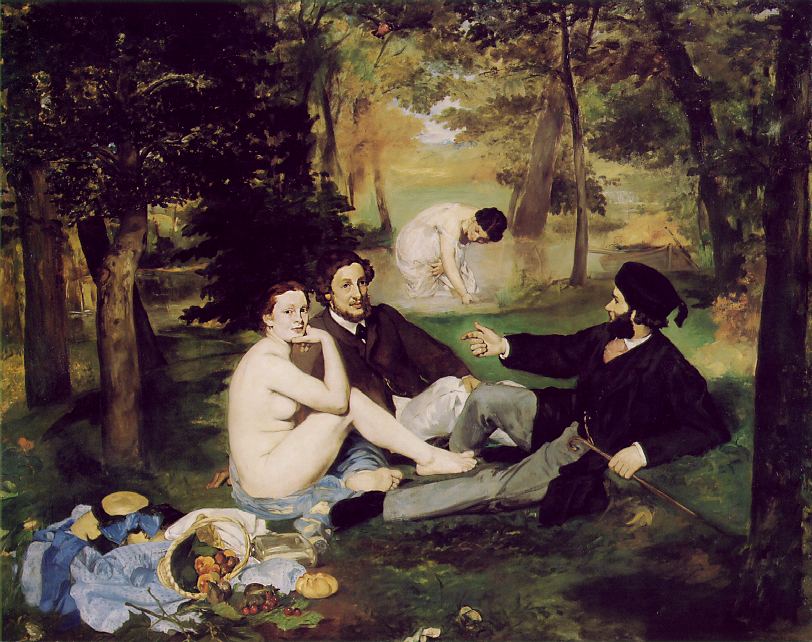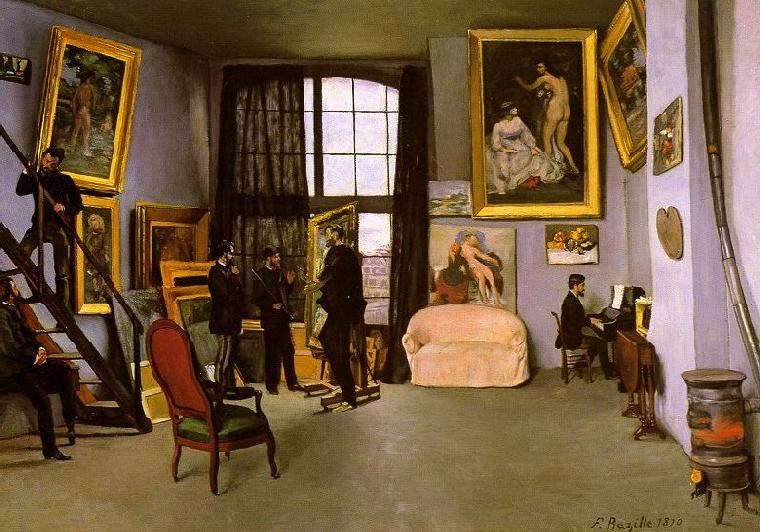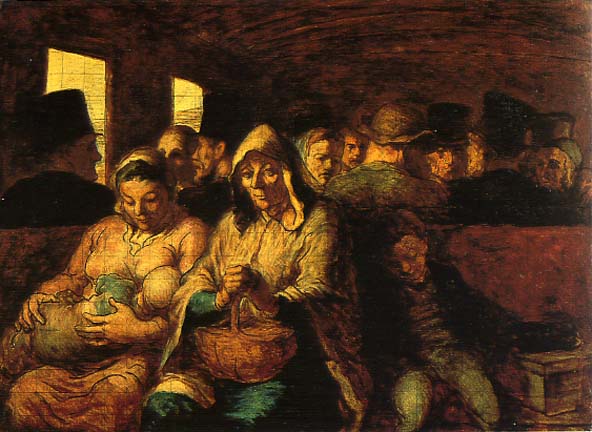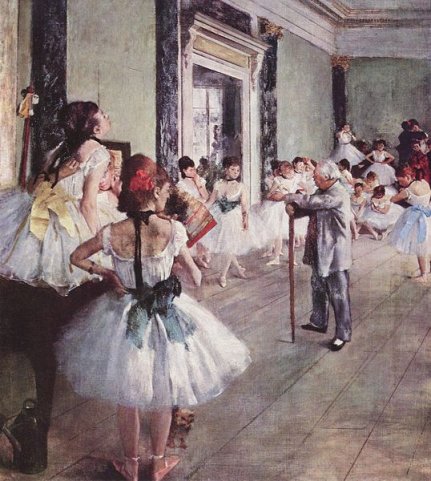He strove only for official recognition; he never thought of himself as making a protest, overthrowing the art of the past, or creating a new order. Yet that is exactly what he did: Edouard Manet, the reluctant revolutionary.

Met:Hilaire-Germain-Edgar Degas (French, Paris 1834–1917 Paris) portrait of Édouard Manet (French, Paris 1832–1883 Paris) Title Édouard Manet, Seated, Holding His Hat Date ca. 1865 Medium Graphite and black chalk on wove (China) paper
Edouard Manet, having been born on January 25, 1832, must have been a few months one side or the other of his thirty-second birthday when his friend Edgar Degas, a couple of years younger, made the drawing of him above. If Manet looks older, the thinning hair and the beard are part of the explanation. And the costume, from our distance of a hundred and fifty years, looks staid. Actually Manet was something of a dandy, as the spats and bowler indicate, and if he walked to Degas’s studio that day, he might have chose to come by way of one of the new boulevards that, still raw in spots, were being gashed through Paris according to Haussman’s plan.
He might have strutted a bit, for he had a quick eye for women and they for him. Also there would have been a good chance of his being recognized by strangers, since he had been conspicuous in the news during the past months. But if he strutted, it could have been with some protective defiance, since the chances were better for his being recognized as a notorious figure than as an artist of consequence. He was not one of those people who equate notoriety with fame.

Henri Fantin-Latour made a formal declaration of allegiance to manet with this portrait of him working at his easel. Seated next to manet is Zacharie Astruc, a painter, writer and defender. Standing behind them, from the left, are the german painter Otto Scholderer, Renoir, Zola, Edmond maitre, Bazille and Monet.
The Manet of Degas’s portrait was between scandals. During the spring of 1863 he had set the pattern for the scandalous success- for attention through outrage- that has been deliberately cultivated for profit by opportunistic artists ever since. But it was not a pattern that he had wanted to set, and he found no profit in it. Until the end of his life, the reserved and perhaps even somewhat puzzled man who is revealed in Degas’s drawing wanted only one kind of success, the conventional success of popular acclaim and official honors, the success of the ribbon in the lapel.
Manet did not need to paint for money; he was a member of a social class new in his century, the bourgeois patrician, and he had inherited adequate means if not real wealth. But even if the food on his table depended on his changing his way of painting to a popularly and officially accepted one, he could not have done so, not because he was under any limitations of talent, but because he seems always to have been a painter who went about his work with a certainty that was inborn rather than calculated.

" however, it was not Spanish Guitar Player which brought him his much sought after recognition but the rejected Dejeuner sur l'herbe (1863). The Salon jury of 1863 had been exceptionally brutal and thousands of paintings had been refused. To counter these refusals, the Salon des Refuses was established and it was here that Dejeuner sur l'herbe (also known as the Luncheon on the Grass) was exhibited. Although influenced by Raphael and Giorgione, Dejeuner did not bring Manet laurels and accolades. It brought criticism. Critics found Dejuener to be anti-academic and politically suspect and the ensuing fire storm surrounding this painting has made Le Dejeuner sur l'herbe a benchmark in academic discussions of modern art. The nude in Manet's painting was no nymph, or mythological being...she was a modern Parisian women cast into a contemporary setting with two clothed man. Many found this to be quite vulgar and begged the question "Who's for lunch?" The critics also had much to say about Manet's technical abilities. His harsh frontal lighting and elimination of mid tones rocked ideas of traditional academic training. And yet, it is also important to understand that not everyone criticized Manet, for it was also Dejeuner which set the stage for the advent of Impressionism."
Although he was a lively leader of the discussions at the Café Guerbois where a group of young artists met, he was not much of a formal intellectualizer. He established a new aesthetic in painting by trusting his hand and his eye, but left to others the job of formulating the statements of his principles after the fact of his achievement. Conservative by temperament, he could have seemed radical only to the reactionaries who were entrenched in the offices where the kind of success he wanted was dispensed.
The irony of Manet’s battle for their favor is that by rejecting him they knocked the first hole in the foundation upon which their whole structure of privileged authority rested. The scandal of 1863, with manet victimized at its center, marks the beginning of the modern artist as a man whose creative independence is subject to no check beyond his own conscience.

The artistic good life, at least for Bazille, who had money as well as talent; seems to have combined the best of two worlds, the bohemian and the bourgeois. He stands beside an easel in his comfortable studio, while Manet comments on a painting.A musician friend, Edmond Maitre, is at the piano. The others are probably Claude Monet with a pipe behind Manet; Emile Zola on the stairs, who had made the outrageous prophecy that manet wou
ang in the Louvre which did come true in 1907. Finally, there is Auguste renoir seated.The idyllic surface of the world in which this revolution took place is poignantly evoked in the studio interior above painted by a fortunate young mann named Frédéric Bazille. Handsome, wealthy, and talented, Bazille had come to paris to combine the studies of medicine and art, had failed the medicine happily enough, and at twenty-eight was finding everything he wanted: first, the approval of his masters, the acceptance in annual exhibitions, and along the way a group of friends- painters, writers, musicians- who worked and talked together.
It is the happiest kind of scene, this gathering in Bazille’s studio, and the halycon spirit extends beyond this pleasant room, through the window and into the city. Paris was the center of the art world and proud of it. The government supported or sponsored a system of schools, studios and exhibitions dominated by the Academy of Fine Arts, where the nation honored its great men during their lifetimes and where, from their Olympian height, they encouraged and disciplined young talents, and guided the taste of the largest and hungriest public that art had ever attracted.

"Cabanel's Birth of Venus (Musée d'Orsay, Paris) created a sensation at the Salon of 1863, which was known as the "Salon of the Venuses" because several paintings of the goddess were exhibited. This painting embodies the ideals of academic art in its careful modeling, polished surface finish, and mythological subject. Cabanel's picture established his reputation, and it was purchased by Napoleon III for his personal collection. In 1875, the American banker John Wolfe commissioned the present canvas, one of numerous replicas Cabanel made after the original. Source: Alexandre Cabanel: The Birth of Venus
Thousands of people crowded into the Salons, the official exhibitions where talent and industriousness were rewarded by prizes that launched new careers or boosted established ones to new levels. The Salon was the annual climax when the arts of painting and sculpture, so assidiously cultivated, bloomed to the glory of France. One had only to prove oneself to share in this glory.
Such was the idyll. But human frailty had reduced the benevolent institution of official patronage in France to the level of organized favoritism, while the admirable academic intention of preserving and developing the best expressions of French creative genius had been debased into the enforcement of dogma. In the second half of the nineteenth century in France, the whole system of instruction, patronage and proselytization of art seemed directed toward the discouragement of a painter whose talent was applied to anything but docile enthusiasm for imitating the threadbare formulas of the pedants who vitiated the system.
Two of the young painters in Bazille’s picture, Renoir and Monet, were to be among the vigilantes who fought the institution to a triumphant finish. Manet, the distinguished visitor in front of the easel, had already been made a rebel in spite of himself, and was still suffering in his attempt to win honors from the forces of reaction with paintings that violated their code and threatened their fortress.

Gustave Caillebotte. 1875. ""The Floor-scrapers" or "Floor-strippers". Probably painted in the family home in the Batignolles area. It is typical of Caillebotte's taste for unusual perspectives and scenes from modern life, including so humble an occupation as floor scraping."
The absolute power of a Paris Salon jury in Manet’s time is difficult to imagine today when the functions of taste-making and picture-selling have been dispersed around the world among dealers, museums, art schools, cultural foundations, and various fringe organizations , all of them grinding their axes in competition with one another, and all with access to hundreds of sources of publicity. The Salon in its day stood alone and impregnable.
True, there were rivalries within the walls, and true, also, Salon juries varied from occasionally liberal to generally hidebound. But since the Salon represented officialdom in the arts,and since officialdom is by its nature concerned with the perpetuation of the status quo to which it owes its existence, the Salon was hardly a breeding ground for change. There were then few dealers in Paris, and even fewer that were not essentially Salon outlets.
Painters with new ideas worked their way into acceptance only painfully and over many years. By the time they were established in the Salon and of sufficient consequence to serve on its juries, they were themselves likely to look with suspicion on innovations, even those that might have grown out of their own. Corot, a gentle spirit whose art contributed so much to impressionism, referred to the impressionists with contempt when, in his old age, these young men who admired him declared their independence from the Salon.
…”I’d forgotten how badly these various painters–Manet, Monet, Renoir, Sisley, Pissaro, etc–all wanted so badly to be part of the Salon. I was fascinated by how Caillabotte could paint such an extraordinary piece, and still expect to be admitted! Like, no. They weren’t going to let you in with that piece and, looking at it with history on my side, why on earth did you even want to be associated with all those lustless nude portraits of Greek goddesses anyway? Except, of course, artists want to be accepted. And then I got to the rooms where we learned all about how the artists hung out at Cafe Batignolle. And how they worked together–there are two paintings of the same dead heron by different artists–and how they joked with each other–Bazille painting his friends but leaving himself out of the picture and then Manet putting in a portrait of Bazille and making Bazille taller than anyone else–and the entire show was suddenly humanized.” ( Marie Mockett ) …
The 1863 jury, which seems to have been dominated by a now-forgotten medoicrity named Signol, rejected at least three thousand paintings. Since a good five thousand had been submitted, this still left what sounds like a big enough show. But as Salons went, the proportion of rejections was regarded as a massacre. The word is not too strong, since a rejected artist suffered from more than wounded vanity and damaged prestige. The rejected painting became unsalable at any decent price to a public unsure of its own judgements and fully confident of the Salon’s. Acceptance in the Salon did not insure a painting’s sale, but rejection put it in the class of defective merchandise.
… “What’s more, there were no paintings fit for tablecloths and umbrellas, though certainly you can buy such items at the end of the exhibit if you want to. Instead, we see pieces that did get accepted into the Salon, and we see how close but not quite close enough the Manets and Monets were. In other words, you can really see how at first, these artists don’t seem to have come out of nowhere. They have the techniques down. It’s just–they had these ideas. And their ideas led them into temptation and then, well, there’s nothing so corrupting as an idea. (To be fair, the Salon paintings are very accomplished. It’s just–nude pink saintly dead gods, yada yada yada. How many centuries of the same thing do we need? Wouldn’t the truculent Greeks be pissed off by poor Jason and the Argonauts and that weird scarf tied around his penis?) We see how the Spanish painterly style influenced Manet. We see how each artist–Pissaro, Sisley and all the rest–develop increasingly personal styles. That’s a roller coaster for an artist–once you are on a personal path, there is no getting off. And yet still they hoped to belong and in the absence of being able to do so. So instead of more chewy Renoir paintings and happy Monet flowers, you see a snowy landscape with a magpie. There’s Whistler and his mother. And lots of Manet, which was helpful because I never quite had a fix on Manet before….
…And then there are all the characters–Emile Zola shows up. It all made me wish for a pair of pants and a nice cafe. Because of course, these were all men. Where, I wonder, is that cafe now? Are there still artistic movements like this where people are trying to overthrow one establishment? Or is the establishment now a fluid thing and fragmented, as everyone keeps trying to tell us the entertainment world is. In hindsight, these artistic struggles look romantic, but of course they are not. They are quite existentially awful. It did so make me wish to be part of something, though.” ( Mockett )
The







 COMMENTS
COMMENTS